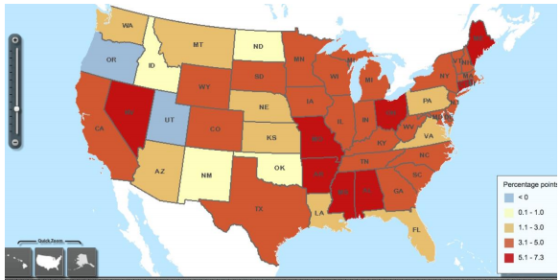By Ryan S.
The USDA defines a Food Desert as a “part of the country vapid of fresh fruits, vegetables, and other healthful whole foods, usually found in impoverished areas.” These areas lack healthy food options because there’s a lack of grocery stores, farmers’ markets, and other means of attaining healthy food. To be considered a food desert, communities must have a poverty rate of at least 20 percent and at least one third of the population must live a mile away from a supermarket in heavily-populated, urban areas or ten miles away in rural areas. The USDA estimates that over 23.5 million Americans (7 percent of the US population) live in food deserts. Only about 50 percent of these Americans are low-income, though areas with many people who can’t afford food — as seen in the figure below — align with some of the low-income states in the south. But despite what appears to be a meaningful correlation, the existence of food deserts isn’t simply caused by poverty. Poor accessibility and demand for healthy food options might also create food deserts.

Regardless of its cause, the existence of food deserts is a pressing issue. Researchers have found that low access to healthy, affordable foods is linked to diabetes as well as adult and childhood obesity. This seems counter-intuitive, but without the means to buy fresh produce, families must rely on pre-packaged foods. Of course there are grocery stores in low-income areas, but without local residents that can afford fresh produce, many grocery stores can’t afford to keep produce in the store; this kind of area is also classified as a food desert. The people that can afford fresh produce then have no nearby place to buy it. Families that either cannot afford fresh fruits and vegetables or who do not have a provider nearby are forced to rely on pre-packaged foods that are high in sodium, sugar, and fat. Our country’s growing consumption of these processed foods is one of the main contributors to our obesity issue.
People in these low-income areas live with many other health concerns. The impoverished are disadvantaged geographically and financially that then leads to poor diet, which affects all aspects of life. Welfare programs attempt to assist low-income families with issues such as hunger and homelessness, but so many Americans still struggle to put healthy and whole food on the table. Programs like the Supplemental Nutrition Assistance Program (previously known as Food Stamps) assist many of these low-income families, but that will only help 50 percent of those living in Food Deserts. Geographic location in relation to healthy food suppliers is almost equally as important. There must first be outreach in order to fill in these gaps of dietary health.
Click to access pb2014-urban-and-rural-food-deserts-in-nebraska.pdf
http://www.worldometers.info/world-population/us-population/

